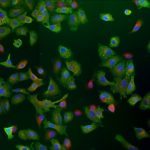Link to Pubmed [PMID] – 12490387
Virology 2002 Nov;303(2):240-52
Using a genetic system that allows the in vivo reconstitution of active ribonucleoproteins, the ability to ensure transcription/replication of a viral-like reporter RNA harboring the G(3) –> A(3), U(5) –> C(5), and C(8) –> U(8) mutations (triple 3-5-8 mutations) in the 3′ arm of the promoter was examined with core proteins from human or avian strains of influenza A viruses. The efficiency of transcription/replication of the viral-like RNA with the triple 3-5-8 mutations in COS-1 cells was found to be slightly decreased as compared to the wild-type RNA when the polymerase was derived from a human virus. In contrast, it was found to be considerably increased when the polymerase was derived from an avian virus, in agreement with published observations using the avian A/FPV/Bratislava virus (G. Neumann and G. Hobom, 1995, J. Gen. Virol. 76, 1709-1717). This increase could be attributed to the compensation of the defect in transcription/replication activity in the COS-1 mammalian cell line due to the presence of a glutamic acid at PB2 residue 627, characteristic of avian strains of influenza viruses. Our results thus suggest that PB2 and/or cellular proteins interacting with PB2 could be involved in RNA conformational changes during the process of transcription/replication.




